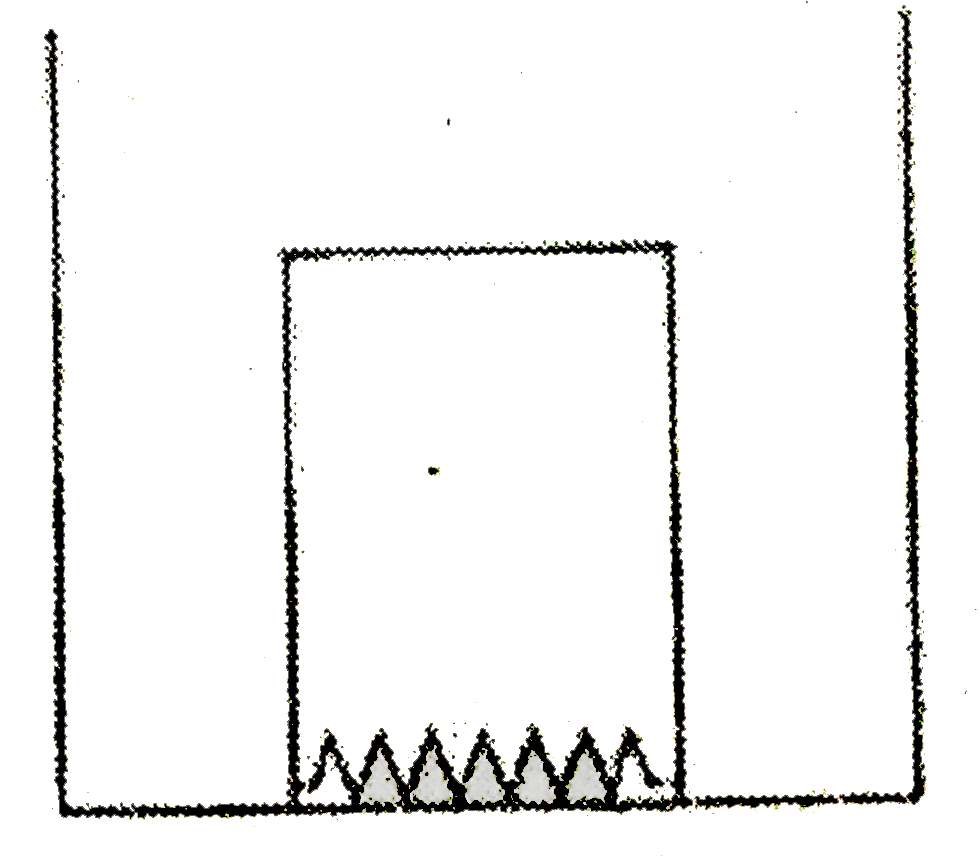A metal cube of edge 5 cm and density 9.0cm−3 is suspended by a thread so as to be completely immersed in a liquid of density 1.2gcm−3. Find the tension in thread. (Take g=10ms−2)
The correct Answer is:9.75N
To find the tension in the thread suspending the metal cube, we will follow these steps:
Step 1: Calculate the Volume of the Cube
The volume V of a cube can be calculated using the formula:
V=edge3
Given that the edge of the cube is 5 cm:
V=5cm×5cm×5cm=125cm3
Step 2: Calculate the Mass of the Cube
The mass m of the cube can be calculated using the formula:
m=V×density
Given that the density of the cube is 9g/cm3:
m=125cm3×9g/cm3=1125g
Step 3: Calculate the Weight of the Cube
The weight W of the cube can be calculated using the formula:
W=m×g
Given that g=10m/s2 and converting grams to kilograms (1 g = 0.001 kg):
W=1125g×10−3kg/g×10m/s2=1125×0.01=112.5N
Step 4: Calculate the Buoyant Force
The buoyant force Fb can be calculated using Archimedes' principle:
Fb=ρ×V×g
Where ρ is the density of the liquid, given as 1.2g/cm3:
Fb=1.2g/cm3×125cm3×10−3kg/g×10m/s2
Calculating this:
Fb=1.2×125×0.001×10=1.5N
Step 5: Calculate the Tension in the Thread
Using the equilibrium of forces, we can express the tension T in the thread:
T=W−Fb
Substituting the values we found:
T=112.5N−1.5N=111N
Final Answer
The tension in the thread is 111N.
---
The volume V of a cube can be calculated using the formula:
V=edge3
Given that the edge of the cube is 5 cm:
V=5cm×5cm×5cm=125cm3
The mass m of the cube can be calculated using the formula:
m=V×density
Given that the density of the cube is 9g/cm3:
m=125cm3×9g/cm3=1125g
The weight W of the cube can be calculated using the formula:
W=m×g
Given that g=10m/s2 and converting grams to kilograms (1 g = 0.001 kg):
W=1125g×10−3kg/g×10m/s2=1125×0.01=112.5N
The buoyant force Fb can be calculated using Archimedes' principle:
Fb=ρ×V×g
Where ρ is the density of the liquid, given as 1.2g/cm3:
Fb=1.2g/cm3×125cm3×10−3kg/g×10m/s2
Calculating this:
Fb=1.2×125×0.001×10=1.5N
Using the equilibrium of forces, we can express the tension T in the thread:
T=W−Fb
Substituting the values we found:
T=112.5N−1.5N=111N
The tension in the thread is 111N.
Topper's Solved these Questions
- BOOK - ICSECHAPTER - UPTHRUST IN FLUIDS, ARCHIMEDES' PRINCIPLE AND FLOATATIONEXERCISE - EXERCISE 5(B)18videos
UPTHRUST IN FLUIDS, ARCHIMEDES' PRINCIPLE AND FLOATATION
- BOOK - ICSECHAPTER - UPTHRUST IN FLUIDS, ARCHIMEDES' PRINCIPLE AND FLOATATIONEXERCISE - EXERCISE 5(B) (Multiple Choice Question)3videos
UPTHRUST IN FLUIDS, ARCHIMEDES' PRINCIPLE AND FLOATATION
- BOOK - ICSECHAPTER - UPTHRUST IN FLUIDS, ARCHIMEDES' PRINCIPLE AND FLOATATIONEXERCISE - EXERCISE 5(A) (Multiple Choice Question)3videos
UPTHRUST IN FLUIDS, ARCHIMEDES' PRINCIPLE AND FLOATATION
- BOOK - ICSECHAPTER - SOUNDEXERCISE - TOPIC 2 Infrasonic and Ultrasonic Waves ( 3 Marks Questions)3videos
SOUND
Similar Questions
A metal cube of side 5 cm and density 7.9gcm−3 is suspended by a thread and is immersed completely in a liquid of density 1.1gcm−3, Find (a) the weight of cube (b) the upthrust on cube and (c) the tension in thread. (Take g=10ms−2)
View SolutionA metallic sphere of mass 3 kg in air is held by a string so as to be completely immersed in a liquid of relative density 0.8. The relative density of metallic sphere is 10. The tension in the string is :-
View SolutionA solid of volume 5 m3 is immersed completely in a fluid of density 0.5 kg m−3. What is the buoyant force acting on it? [Take g = 10 m/s2]
View SolutionEqual masses of water and a liquid of density 2g/cm3 are mixed together. The density of mixture is:
View SolutionA metal piece weighs 200gf in air and 150 gf when completely immersed in water.
How much will it weigh in a liquid of density 0.8gcm−3 ?View Solution(a). A cube of side 5 cm is immersed in water and then in saturated salt solution. In which case will it experience a greater buoyant force. If each side of the cube is reduced to 4 cm and then immersed in water, what will be the effect on the buoyant force experienced by the cube as compared to the first case for water. Given reason for each case.
(b). A ball weghing 4 kg of density 4000 kg/m3 is completely immersed in water of density 103kg/m3 find the force of buoyancy on it. (given g=10m/s2)View SolutionTwo solids A and B of density 2.5 g cm−3 and 0.80g cm−3 are placed in a liquid L of density 1.2 g cm−3 Which solid is likely to float and why?
View SolutionTwo spheres of volume 250 cc each but of relative densities 0.8 and 1.2 are connected by a string and the combination is immersed in a liquid. Find the tension T in the string. (g=10m/s2)
View SolutionA silver block of mass 3.1 kg is connected to a string and is then immersed in a liquid of relative density 0.82 . Find the tension in the string , if relative density of silver is 10.5
View SolutionA cube (side =10cm) of density 0.5g/cm3 is placed in a vessel of base area 20cm×20cm. A liquid of density 1.0gcm2 is gradually filled in the vessel at a constant rate Q=50cm3/s

If we plot a graph between the normal reaction on cube by the vessel versus time. The graph will be likeView Solution

